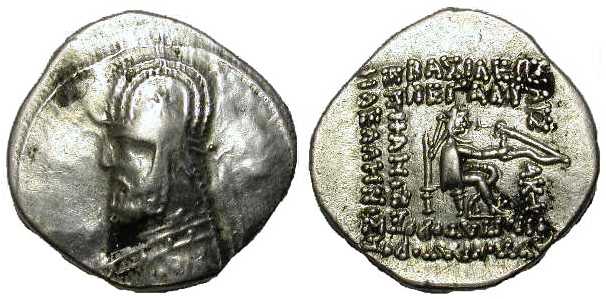| 80 BC - 77 BC |
Ορώδης Α'
| Drachm / Δραχμή AR |
SHH 804 |
 |
| Parameter Obverse Reverse Notes Reference Provenance Composition |
4.10
g 19.2-21.0
mm 12:00 o'clock VF σmax(SigmaTest, 240 Hz) = obv. 20.3 rev 19.2 MS/m μ-XRF ground edge 12 % Cu Cuirassed bust left with medium length beard, wearing tiara ornamented with star; border of dots. Archer seated on throne right holding bow; above ΒΑΣΙΛΕΩΣ/ΜΕΓΑΛΟV, on right ΑΡΣ/ΑΚΟV, in exergue ΑVΤΟΚΡΑΤΟΡΟΣ/ΦΙΛΟΠΑΤΟΡΟΣ, on left ΕΠΙΦΑΝΟVΣ/ΦΙΛΕΛΛΗΝΟΣ. ? Copenhagen 65/68 (Sinatrukes 77-70 BC); Sear Greek 7389; Sellwood 31.6 Ex Harlan J.Berk, 13.12.2001 XRF-Analysis, surface patina Rathgen OXFORD-Analyser
|
|
Orodes
I
(90-80 BC)
http://www.cgb.fr/monnaies/vso/v16/gb/monnaiesgb68fc.html?depart=88&nbfic=2000
Orodes
Ier est considéré comme un
usurpateur. Il pourrait avoir été de sang royal. Il se
débarassa de
Gotarzès Ier et régna peut-être pendant une dizaine
d'années après la
mort de Mithridates II. C'est l'une des période les plus
troubles de
l'histoire arsacide.
Orodes
I
(87-80 BC)
http://www.donaldhs.vic.edu.au/home/spotter/Parthian_Empire.html
When Mithradates died in 87 BC the Parthian empire was at its' height. Upon his death a civil war broke out between his sons Gotarzes King of Babylon and Orodes I King of Media, both of whom eventually became King of Parthia. Elam broke away immediately under the leadership of a Elamite noble Khumbadara (Humban-Tahrah) in 87 BC. The same year Armenia, Adiabene and Gordeyne (the latter two together known as Assyria), and the satrapy of Persis (Persia) broke away. At the same time the Seleucid empire of Syria was disintegrating further as well. Syria became a Roman province, the Seleucids were reduced to ruling Commagene and Sophene became independent as did Osroene. Upon the death of Orodes I in 77 BC, the Parthian clans elected the elderly Sanatruces a son of Phraates I who was aged 85 at his accession. He died in 70 BC aged 92, and was succeeded by his son the present King Phraates III who was aged 50 at his accession and the father of many sons. Orodes I
(90-80 BC)
http://www.cgb.fr/monnaies/vso/v16/gb/monnaiesgb68fc.html?depart=88&nbfic=2000
Orodes
Ier est considéré comme un
usurpateur. Il pourrait avoir été de sang royal. Il se
débarassa de
Gotarzès Ier et régna peut-être pendant une dizaine
d'années après la
mort de Mithridates II. C'est l'une des période les plus
troubles de
l'histoire arsacide.
Orodes I
(87-80 BC)
http://www.donaldhs.vic.edu.au/home/spotter/Parthian_Empire.html
When Mithradates died in 87 BC the Parthian empire was at its' height. Upon his death a civil war broke out between his sons Gotarzes King of Babylon and Orodes I King of Media, both of whom eventually became King of Parthia. Elam broke away immediately under the leadership of a Elamite noble Khumbadara (Humban-Tahrah) in 87 BC. The same year Armenia, Adiabene and Gordeyne (the latter two together known as Assyria), and the satrapy of Persis (Persia) broke away. At the same time the Seleucid empire of Syria was disintegrating further as well. Syria became a Roman province, the Seleucids were reduced to ruling Commagene and Sophene became independent as did Osroene. Upon the death of Orodes I in 77 BC, the Parthian clans elected the elderly Sanatruces a son of Phraates I who was aged 85 at his accession. He died in 70 BC aged 92, and was succeeded by his son the present King Phraates III who was aged 50 at his accession and the father of many sons. |